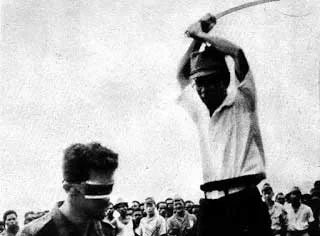The Beheading of Jose Dimaandal by the Japanese in Batangas Town in 1943
Filed away at the National Library of the Philippines are so-called “historical data” for the different towns across the Philippines. These were required by the administration of then-President Elpidio Quirino of all Bureau of Education divisions across the country to reconstruct local histories destroyed during the Second World War.
The information contained in these documents cannot be said to be all reliable, since these documents were researched by public school teachers in their respective communities, often reliant on elders rather than verified documents.
However, the most reliable information will have to be those collected about World War II, inasmuch as the war ended less than a decade before the “historical data” was collected and events were still fresh in the minds of the people in the community.
One of these events was the beheading of a former public school teacher in the then town of Batangas in April of 1943 merely for resisting Japanese soldiers who presumably were attempting to take him into custody for an offense of which he was not even guilty1.
 |
| Decapitation of an Australian soldier in PNG by a Japanese soldier. Public domain. Image source: Wikipedia. |
In January 1942, the Japanese Army rolled into the town of Batangas unopposed since United States forces, including its Filipino soldiers, had been ordered by General Douglas MacArthur to retreat for a consolidated stand against the invaders at the Bataan Peninsula2.
The subsequent surrender of the United States forces to the Japanese Imperial Army later that same year did not mean passive acceptance of the invaders’ occupation of the country. American and Filipino soldiers who somehow managed to escape Japanese capture went underground and started forming resistance movements.
To learn more about the formation of guerrilla movements in Batangas, READ: “The Recruitment and Organization of Anti-Japanese Guerillas in Batangas in WWII.”
In the town of Batangas, the formation of a guerrilla unit was started by a former army officer just named “Mr. Espina” by the “historical data” for the town of Batangas. Soldiers of the occupying army had not endeared themselves to the local populace, so before long “many prominent citizens joined this organization.” Guerrilla headquarters were established in the barrios of Balagtas, Tinga and Sorosoro.
In April of 1943, great quantities of flour, rice and canned goods were stolen from the storage house of the Japanese Army garrison stationed at the campus of Batangas High School. The guerrillas, who naturally needed provisions, were the natural suspects for the theft.
The Japanese, on information that the goods “were taken across the Calumpang River,” sent patrols the next day to Libjo in search of the missing goods. What happened was described in the “historical data” for “poblacion” Batangas Town:
“All [the] men found beyond the river up to Mahabang Dahilig were rounded up and assembled at the bank of the river along M. H. del Pilar Street. The people rounded [up] numbered about 2,000. They were all ordered by the guards to sit or squat on the hot ground and under the hot sun from morning up to 2:00 o’clock in the afternoon without food or water to drink. Then suddenly, they were ordered to march in double file to the Batangas High School campus. Upon reaching the Batangas High School grounds, the detainees were ordered to sit on the ground. They were heavily guarded with soldiers having fixed bayonets and some with machine guns.”
What the Japanese Army, obviously, wanted from the men rounded up was information about who was responsible for the theft, something that, according to the document, nobody volunteered.
Late that same afternoon, a truck came to unload two captured citizens, the former public school teacher Jose Dimaandal and one Vicente Marasigan. Speaking through an interpreter, the Japanese captain presumably in charge of the garrison announced that while neither Dimaandal nor Marasigan were the thieves, they were to be publicly beheaded for resisting Japanese soldiers.
Decapitation or beheading was part of Japanese samurai culture and was a fairly “common punishment, sometimes for minor offenses.” In World War II, the decapitation of enemy soldiers and civilians by Japanese soldiers was thought of to have been “acts of contempt3.”
A Japanese merchant named Oyawake, presumably based in the town even prior to the Japanese occupation and sympathetic to the plight of the locals, tried to plead with the officer for the release of both Dimaandal and Marasigan. For some unknown reason, the latter was set free.
Dimaandal, however, “was led by four Japs to the direction west of the Batangas Trade School where eyewitnesses said his head was cut off.” As gory as his execution may sound, the unfortunate fact is that he would be just one of an estimated 25 thousand Batangueños massacred by the Japanese during their infamous reign of terror in the Philippines.
To learn more about Japanese atrocities committed in Batangas during World War II, READ: “When 25,000 Batangueños were Massacred by the Japanese in World War II.”
2 The Fall of the Philippines,” by Louis Morton, 1953, online at the History of the United States Army.
3 “Decapitation,” Wikipedia.
